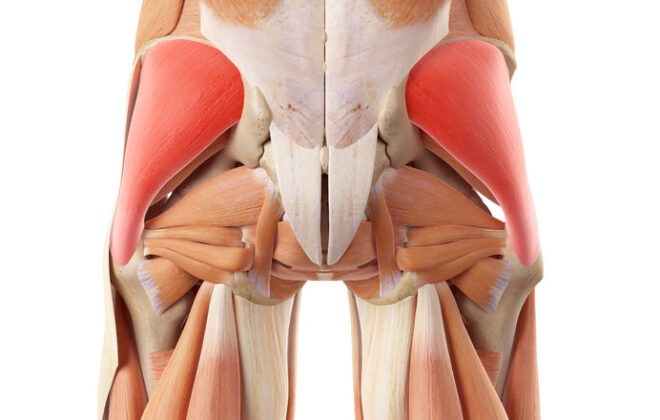Piriformis Strengthening – Do’s And Don’ts For Pain Relief
If you’re suffering from piriformis issues, ranging from simple weakness to pain, then you’re in the right place.
Piriformis strengthening is crucial if you want strong and stable hips. In this article, I’ll cover how to start from very simple to more advanced, and also address how to approach exercising if you’re dealing with a painful piriformis.
Note: If you’re dealing with piriformis issues and need a specific step-by-step protocol, be sure to check out my Piriformis Protocol program.
Piriformis Muscle Location And Movement
The piriformis muscle is one of 6 muscles called the “Deep Six” that are found on the back of the hip. Together these muscles externally rotate the leg.
It attaches at the sacrum bone and inserts into the greater trochanter.
It’s also important to note the sciatic nerve is located just under the piriformis muscle (and in some individuals the nerve travels through it.
How To Strengthen The Piriformis
Since the piriformis primarily is an external rotator of the leg, the main exercises for this muscle involve external rotation. It also functions as a stabilizer for the hip, so it can be trained with single leg balance exercises as well.
While it is not discussed often, the piriformis, due to its location, acts as a medial/internal rotator of the hip when the hip is position at greater than approx 60 degrees of hip flexion.
Since this dual function is fairly confusing, I’ll tackle how to strengthen the internal rotation function in a separate post.
This muscle works with other paired muscles in this movement, so you will not be able to directly isolate it.
Critical Notes If You’re Dealing With Piriformis Syndrome
Stretches and exercises for piriformis syndrome can be a bit of a mine field. The nature of the condition is one of varying levels of nerve sensitivity and tolerance to movement and exercise.
While its common for many people to self-diagnose via “Dr. Google” these days, it is important to have a proper screening and diagnosis before doing any self therapy.
In particular, piriformis syndrome and sciatica, although two completely different conditions, often are used to explain the same symptoms.
Sciatica involves irritation of the sciatic nerve, most commonly originating at the lower spine. When buttocks region pain is due to sciatic nerve compression, it should be treated at the spine level to begin with.
Piriformis strengthening isn’t likely to have much if any positive impact.
Piriformis pain is more complex. The condition called piriformis syndrome is not clearly defined. Like many other issues with the “syndrome” label, its a collection of symptoms, although no specific cause can be identified.
Its common for a muscle to become weakened as a result of pain, due to inhibition, so strengthening exercises are often assigned to “fix the weakness”.
This is a chicken egg scenario. Did the pain cause the weakness, or the weakness cause the pain?
Regardless, it has been my experience in working with many challenging piriformis syndrome cases in my career that many have responded poorly, not at all, or made worse with aggressive piriformis strengthening programs.
Thus I’ve developed a very cautious approach to assigning exercises for this type of situation.
Exercises Virtually Guaranteed To Aggravate Piriformis Syndrome
This may come as a surprise, but I commonly help people improve from piriformis syndrome without doing any direct external rotation isolation exercises.
I find they tend to create flare ups very quickly that sometimes can take days to recover from. This is frustrating and defeating to many people dealing with this problem, especially when they have been told by many well-intentioned therapists to just “work through it”.
I disagree with this approach. I find the following exercises, particularly when initially beginning an exercise program, to be very triggering:
Sidelying Clamshells
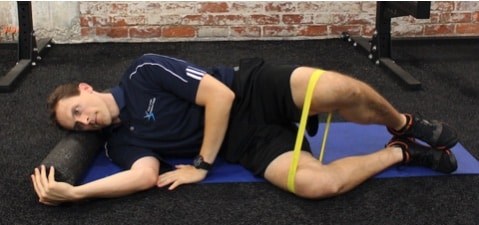
Banded Hip Abductions
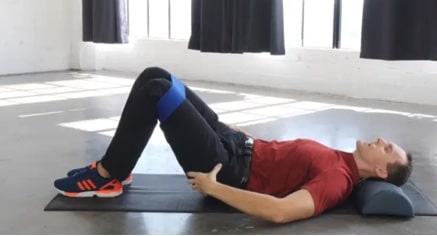
Tubing Walks
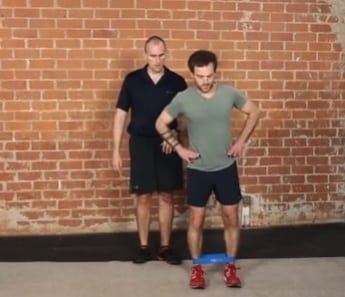
Machine Hip Abductions
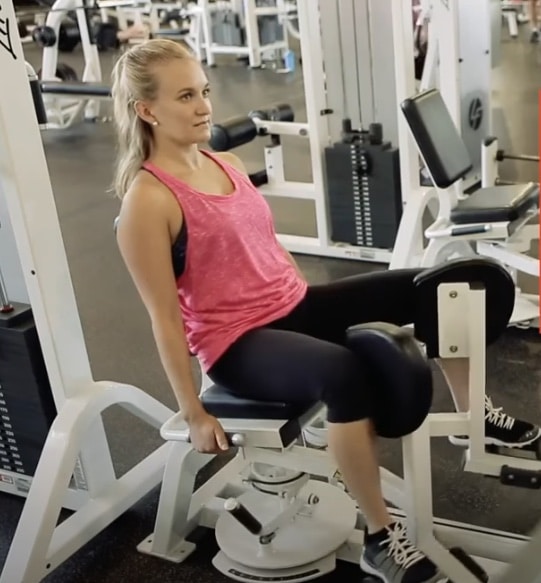
As you can see, these are the MOST commonly advised exercises for piriformis syndrome!
Now to be clear, I’m not saying these exercises will not help anyone. What I am saying is that they tend to be too aggressive for more challenging cases of piriformis syndrome.
Non-Aggravating Exercises For Piriformis Syndrome
Piriformis syndrome exercises should be done with primarily the intention of allowing for NON-threatening movement. The outcome is pain relief, not muscle strengthening or endurance training.
Its simply to be able to perform movement with excessive stimulation or fatigue that may result in a flare up of more pain.
My go-to movements are ones that are extremely low loading on the muscle, can be performed for approximately 2 minutes at a controlled pace, and generate virtually no direct muscle fatigue.
This allows for nerves to calm down after being exposed to movement that doesn’t provoke threat, and therefore reduces guarding and apprehension. Another way to think about it is to convince the nerves they are OK.
Prone Hip Extensions
Sidelying Hip Shifting
Supine Hip Shifts
Step Ups
Split Squats
Piriformis Strength vs. Endurance – Which Is Better?
As mentioned above, isolating the piriformis muscle is not possible. It works in a group of gluteal muscles that externally rotate the hip.
The larger glute muscles are far stronger and more powerful than the smaller, deeper external hip rotators, so traditional strength training exercises such as squats and lunges should be employed to address them.
The piriformis, like most muscles does need to get stronger, needs a good dosage of endurance training as well. This means moderate to higher repetitions (greater than 15).
This will serve as a nice foundation of low resistance training to encourage blood vessel and capillary development in the muscle to resist fatigue and prepare the tissues for more strenuous training later.
Piriformis Stretching
Is the Muscle Actually Tight OR Just Feels Tight?
This is often a very confusing topic, but it’s important to understand. Muscles and joints have “normal” ranges of motion. These are generally well established in orthopedic and physical therapy textbooks.
Testing for normal range of motion should be done to determine if there is indeed shortness in a particular muscle group. However, in my experience, most often the muscle/s FEEL tight or tense, but there is normal range of motion present in the muscle.
When this occurs, a better word to describe the muscle tension would be “facilitated” or over-active. Stretching can still be an effective means for reducing the tightness symptoms, but it changes our intentions when doing stretches and exercises.
I have found the piriformis muscles often have normal range of motion upon testing. The muscle can certainly “feel” tight especially when dealing with piriformis syndrome due to the pain and likely guarding of the muscle. Piriformis release techniques can be helpful as well to reduce over-activity in this muscle without stretching.
Getting The Perfect Piriformis Stretch
Stretching the piriformis isn’t too complicated. Since the muscle externally rotates the hip, we can accomplish a stretch by doing the opposite, which is internal hip rotation.
The additional variable to manipulate is how much flexion in the hip is used. There are 2 primary positions that work best for piriformis stretching; supine and seated.
The standard recommendation for stretching is 3 repetitions, holding for 30 seconds on each stretch.
I always advise against aggressive stretching, and the number of repetitions and/or holding times can certainly be reduced if the nerves are very sensitive to stretch. The key is to find a good tolerance point to start, then build up from there over time.
Supine Piriformis Stretch
90-90 Stretch
Join my FREE insider group and get access to my most effective tools for pain relief.

Enter Your Email Address To Grab Your Tools.
Sam Visnic

Tired of Chronic Pain?
Join my free insider group and get access to my most effective tools for pain relief.
Most Popular Posts
Categories
- Deep Gluteal Pain Syndrome (8)
- Deltoids (2)
- Foam Rolling (2)
- Glutes (9)
- Hamstrings (5)
- Hypnosis for Pain (3)
- Lats (2)
- Levator Scapulae (4)
- Lifestyle (8)
- Massage Therapy (39)
- Mobility (21)
- Movement and Exercise (19)
- Muscles (22)
- Nutrition (2)
- Obliques (1)
- Pain (25)
- Pectorals (3)
- Piriformis (3)
- Plantar Fasciitis (11)
- Psoas (11)
- Quadratus Lumborum (3)
- Quadriceps (2)
- Rhomboids (3)
- Sciatica (1)
- Serratus Anterior (1)
- SI Joint (14)
- Sternocleidomastoid (1)
- Stretching (18)
- Subscapularis (1)
- TMJ (2)
- Trapezius (1)
- Uncategorized (12)

